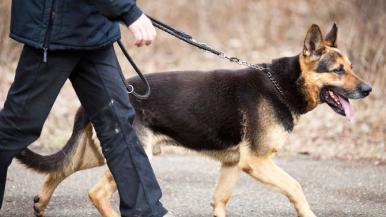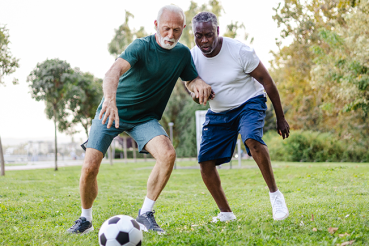You're taking your dog for a walk. It's a beautiful day. You're texting a friend about your upcoming trip to …
Suddenly — faster than you can say, "squirrel!" — your dog takes off.
What happens next could be catastrophic. "You can get seriously hurt," says Mark Cohen, MD, a hand, wrist and elbow surgeon at Rush University Medical Center. "The dog can move quickly and with so much force. And you're at the other end holding just the leash, absorbing all of that energy."
You may not realize how common dog walking and dog handling injuries are. But Cohen and colleague John Fernandez, MD, see them frequently in their practice — everything from severe finger and wrist fractures, to dislocations and ruptured tendons.
Cohen and Fernandez offer these six strategies to help keep you safe:
1. Don't wrap the leash.
It may seem safer to loop the leash handle around your fingers or wrist than to just hold it in your palm. But Cohen says the opposite is actually true.
"If the dog takes off, it happens so quickly that you don't have time to unwrap the leash. By the time you realize there's traction on your fingers or wrist, you may already be falling down, or already have suffered a fracture."
And these are not simple bone breaks, like you'd get from slamming your finger in a door. They tend to be nasty injuries because the leash viciously twists your wrist or fingers. The bones can separate, and there's also likely to be cartilage, ligament and tendon damage.
"Often, you need surgery," Cohen says. "And recovery can take anywhere from several months to a year. Some people never completely recover."
If, however, you hold the leash in the palm of your hand — like you would a golf club or baseball bat — you'll have more control over the dog. You'll be more likely to pay attention if you have to keep a firm grasp at all times. And you can tighten (or loosen) your grip immediately if you feel the dog start to pull away.
2. Don't put your fingers under the collar.
You can also suffer severe twisting fractures if your fingers are under the collar and the dog jumps or pulls away. It's similar to when a football player gets a finger caught in another player's facemask, and the facemask goes one way, the finger another.
"I have a dog, and I tell my kids all the time, 'Do not put your fingers under the dog's collar,' " Fernandez says. "They're trying to hook the leash to the collar, and they leave themselves vulnerable if the dog decides not to sit still."
Try pinching the collar around the edges. Or grasping the attachment ring instead of the collar itself while fastening the leash. It may take a few attempts or some practice, but it's much safer.
Fernandez also advises not grabbing for the collar to separate your dog from another dog. "Not only are you risking fractures, but you can get bitten because the dogs are in a more aggressive mode," Fernandez says. "If a dog clamps down on your finger, the finger can be horribly mangled."
It's especially important to take care with larger, more muscular dogs that can generate more force and have stronger jaws. But even small dogs, if they make sudden movements that catch you off guard, can create enough torque to break your fingers.
3. Keep your dog on a short leash.
The longer the leash, the more leash there is for the dog to pull — and more potential for trouble if the dog takes off.
"Imagine 50 feet of rope. When the dog starts running, by the time it hits the end of the rope, there's a lot of energy built up — energy that will transfer to the rope and, ultimately, the person holding it," Fernandez says.
As a result, you could fall or get dragged, suffering severe bruises or fractures. The hard yank of the leash can cause not only hand and wrist fractures, but tendon or ligament damage — or even dislocations — to your elbow or shoulder. It's also easier to trip on or get tangled up in a longer leash.
Give the dog a little leeway when you stop to let the dog sniff around or do its business (just keep a watchful eye on the dog; don't start checking Twitter). But keep a shorter leash when you're walking, so you have more control over the dog's movements.
Imagine 50 feet of rope. When the dog starts running, by the time it hits the end of the rope, there's a lot of energy built up — energy that will transfer to the rope and ... the person holding it.
4. Walk — don't roll.
Regardless of your skill or comfort level, it's never a good idea to walk your dog while riding a bike, scooter, skateboard or Segway, or while rollerblading or rollerskating.
"When you're on wheels, you're already off-balance and less stable than if you're walking," Fernandez says. "Add the unpredictability of a dog into the equation, and it's a recipe for disaster. If that dog suddenly starts running, it's going to take you down and you're likely to suffer an injury."
5. Wear appropriate shoes.
Just as you wouldn't wear platform wedges on a hike, you shouldn't wear them to walk your dog.
"You have to have the right footwear," Cohen says. "When it's icy or snowy, it's important to wear boots with good traction. But even when it's warm and dry, you need shoes that offer stability and won't trip you up if the dog pulls on the leash or suddenly changes directions."
So leave the flip-flops, sandals, slippers, clogs, high heels and other potentially precarious shoes at home.
It also helps to be aware of the terrain and weather conditions before you start your walk. For instance, if you know the ground will be muddy, opt for sturdy boots instead of sneakers.
6. Most important, pay attention.
"Many injuries my colleagues and I see from dog walking could have been prevented if the person was simply paying attention," Cohen says. "If you're not distracted, you'll be able to react faster to any situation; you won't be caught completely off guard."
That means the following:
- Don't talk on your phone, text or engage in social media.
- Don't wear headphones or a bluetooth headset.
- Scan the surrounding area for things that might attract or frighten your dog, such as other animals or cars.
- Watch where you're walking so you can try to avoid obstacles or unstable terrain.
When to see a doctor
If you suffer an injury while walking or handling your dog, don't ignore it. When you get home, apply ice to the injury for 10 minutes. One hour after icing, seek medical attention if any of the following are true:
- You have significant pain and swelling.
- It hurts when you press on the injured area.
- It hurts when you move your wrist, hand or finger, or you don't have full range of motion.
Even if your symptoms improve, see a doctor if they are not completely gone within 1 to 2 weeks.
"It’s a common misconception that if you can still move your hand, wrist or finger, it's not broken," Cohen says. "Use your judgment, but don't assume that just because the injury was caused by a dog, it can't be serious."




